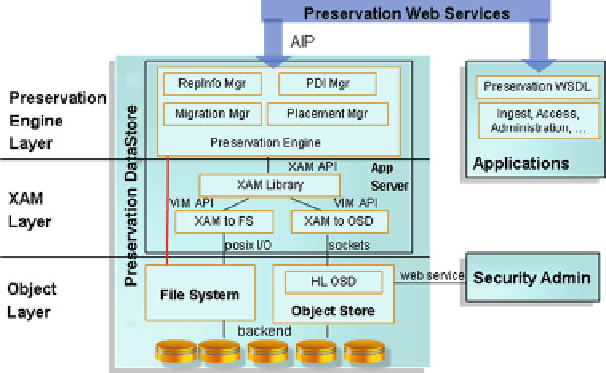Information Technology Reference
In-Depth Information
17.6.2.1 Architecture
PDS has a flexible architecture where each layer can be reused independently
[
189
]. It includes three layers as shown in Fig.
17.14
, each based on an open
standard. At the top, the OAIS-based
preservation engine
layer provides an
external interface to PDS and implements preservation functionalities. This layer
also maps between the OAIS and eXtensible Access Method (XAM) [
190
]lev-
els of abstraction. XAM serves as the storage mid-layer which provides logical
abstraction for objects that include data and large amounts of “metadata”. This
layer contains the XAM Library, which provides the XAM interface, and a
Vendor Interface Module (VIM) to communicate with the underlying storage
system.
The bottom layer of PDS (Object layer) may consist of either of two backend
storage systems: a standard file system, or an Object-based Storage Device (OSD)
[
191
,
192
]. A higher-level API (HL-OSD) on top of OSD provides abstraction and
simplification to the Object Store's SCSI-like interface. OSD is preferred when the
actual disks are network-attached and there is a requirement to access them securely.
For the case where the mid-layer abstraction is not desired, we have an alternative
implementation that maps the preservation engine layer directly to a file system
object layer without using XAM.
Fig. 17.14
Preservation data stores architecture
17.6.2.2 PDS Functionality
PDS exposes a set of interfaces that form the PDS entry points accompanied
with their arguments and return values. The PDS entry points cover some of the
functionality PDS exposes to its users including different ways to ingest and access
data and “metadata”, manipulate previously ingested data and “metadata”, retrieve

